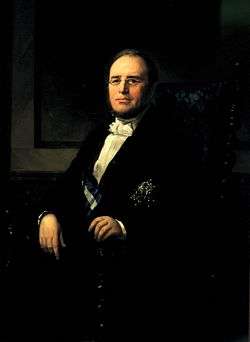Pedro José Pidal
Don Pedro José Pidal y Carniado, 1st Marquis of Pidal (25 November 1799–28 December 1865) was a Spanish lawyer, writer, politician (alcalde,[2][nota 1] deputy and senator) and academician who served important political offices in the reign of Isabella II of Spain, including those of Minister of Gobernación[3] (Interior minister), Minister of State (1848-1849 and 1856-8),[2] Minister of Justice[4] and Speaker (presidente) of the Congress of Deputies[4] (1844-7).[2]

Biography
Pedro José Pidal y Carniado was born in Villaviciosa, Asturias. On finishing his Law studies, he moved to Madrid in 1822 and started working for a prestigious law firm[2] and collaborated with the short-lived daily El Espectador (1821-3), founded by his fellow Asturian liberal, Evaristo San Miguel.[5]
Before becoming increasingly involved in politics, he briefly (c. 1841) held the Chair of History of Government and Legislation in Spain at the Ateneo de Madrid.[2] He became an academician of the Real Academia Española in 1844,[2] of the Real Academia de la Historia in 1847, and director of this institution in 1852.[2]
Pidal Plan
Among the many other reforms carried out by Pidal as Minister of the Interior, the so-called Pidal Plan (1845) —the most important of a series of reforms in Spain's education system that would eventually lead to the so-called Ley Moyano (1857), which would remain in effect until 1970[6]—, implemented the first major overhaul of Spain's education system. Actually drawn up by his friend Antonio Gil y Zárate,[2] the plan called for state-run institutos to be created in each provincial capital[7] and among the many aspects the plan introduced were modifications to the syllabus, with the subjects of Spanish literature introduced at secondary level[8] and geography and Spanish history introduced for both secondary and university students.[nota 2]
The plan also created the first chair in International Law, a post first held, albeit briefly, by Lorenzo Arrazola y García, a former Minister of Justice, future Prime Minister of Spain and President of the Supreme Court.[10]
Family
His son, Alejandro Pidal y Mon (1846–1913) would also become a deputy[11] (as well as Speaker of Congress)[12] and academician (also being appointed director of the Real Academia Española). His grandson, Pedro Pidal Bernaldo de Quirós (1870–1941) would likewise enter politics, becoming both deputy[13] and senador.[14]
Notes
- Not to be confused with the modern term, meaning mayor. With duties similar to those of the corregidor, the main difference being that the corregidor was directly appointed by the monarch for major cities.
- Gil y Zárate stated that "It is shameful that there are people from the distinguished classes of society who do not know what this society has been and how it was formed".[9]
References
- "Galería de Imágenes." Congress of Deputies. Retrieved 25 January 2019.
- Ramos Corrada, Miguel (in Spanish). Biography: "Pedro José Pidal y Carniado." Real Academia de la Historia. Retrieved 25 January 2019.
- Palomeque Torres, Antonio (in Spanish). La Universidad de Barcelona desde el Plan Pidal de 1845 a la ley Moyano de 1857, p. 13. Edicions Universitat Barcelona, 1979. Google Books. Retrieved 25 January 2019.
- Marichal, Carlos. Spain, 1834-1844: A New Society, pp. 195, 197. Tamesis, 1970. Google Books. Retrieved 25 January 2019.
- Hartzenbusch, Eugenio (in Spanish). Apuntes para un catálogo de periódicos madrileños desde el año 1661 al 1870, p. 31. Madrid, 1894. The Internet Archive. Retrieved 25 January 2019.
- Llorent Bedmar, Vincente. "The Stability of Change: Educational Reform in Spain". In: Verdugo, Richard R. Educational Reform in Europe: History, Culture, and Ideology, p. 96. IAP, 2014. Google Books. Retrieved 25 January 2019.
- Dickinson, A.; P. Gordon, P. Lee, J. Slater. International Yearbook of History Education, p. 34. Routledge, 2013. Google Books. Retrieved 25 January 2019.
- Cabo Aseguinolaza, Fernando; Anxo Abuín Gonzalez, César Domínguez. A Comparative History of Literatures in the Iberian Peninsula, Volume 1, p. 27. John Benjamins Publishing, 2010. Google Books. Retrieved 25 January 2019.
- Boyd, Carolyn P. Historia Patria: Politics, History, and National Identity in Spain, 1875-1975, p. 74. Princeton University Press, 1997. Google Books. Retrieved 25 January 2019.
- Rasilla del Moral, Ignacio de la. In the Shadow of Vitoria: A History of International Law in Spain (1770-1953), pp. 50-1. BRILL, 2017. Google Books. Retrieved 25 January 2019.
- File: Pidal y Mon, Alejandro. Congress of Deputies. Retrieved 25 January 2019.
- File: Alejandro Pidal y Mon. Congress of Deputies. Retrieved 25 January 2019.
- File: Pidal Bernaldo de Quirós, Pedro. Congress of Deputies. Retrieved 25 January 2019.
- File: Pidal Bernaldo de Quirós, Pedro, Marqués de Villaviciosa de Asturias. Senate of Spain. Retrieved 25 January 2019.
| Political offices | ||
|---|---|---|
| Preceded by The Duke of Sotomayor |
Minister of State 29 July 1848 – 19 October 1849 |
Succeeded by The Count of Colombi |
| Preceded by The Count of Colombi |
Minister of State 20 October 1849 – 14 January 1851 |
Succeeded by Manuel Bertrán de Lis |
| Preceded by Nicomedes Pastor Díaz |
Minister of State 12 October 1856 – 15 October 1857 |
Succeeded by Leopoldo Augusto de Cueto |